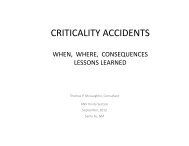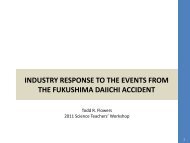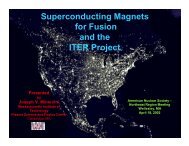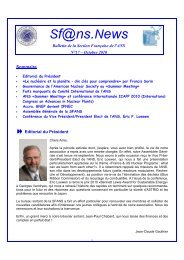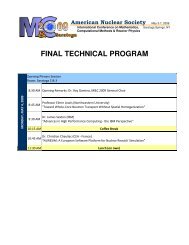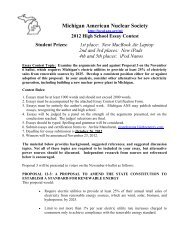DOE-NE-0088
DOE-NE-0088
DOE-NE-0088
You also want an ePaper? Increase the reach of your titles
YUMPU automatically turns print PDFs into web optimized ePapers that Google loves.
adioactive waste, including spent fuel from<br />
nuclear powerplants. It also establishes fees<br />
for owners and generators of radioactive<br />
waste and spent fuel, who pay the costs of<br />
the program.<br />
1983 Nuclear power generates more electricity<br />
than natural gas.<br />
1984 The atom overtakes hydropower to<br />
become the second largest source of electricity,<br />
after coal. Eighty-three nuclear power reactors<br />
provide about 14 percent of the electricity<br />
produced in the United States.<br />
1985 The Institute of Nuclear Power Operations<br />
forms a national academy to accredit<br />
every nuclear powerplant's training program.<br />
1986 The Perry Power Plant in Ohio becomes<br />
the 100th U.S. nuclear powerplant in operation.<br />
1986 April 26. Operator error causes two<br />
explosions at the Chernobyl No. 4 nuclear<br />
powerplant in the former Soviet Union. The<br />
reactor has an inadequate containment<br />
building, and large amounts of radiation<br />
escape. A plant of such design would not be<br />
licensed in the United States.<br />
1987 December 22. The Nuclear Waste<br />
Policy Act (NWPA) is amended. Congress<br />
directs <strong>DOE</strong> to study only the potential of the<br />
Yucca Mountain, Nevada, site for disposal of<br />
high-level radioactive waste.<br />
1988 U.S. electricity demand is 50 percent<br />
higher than in 1973.<br />
1989 One hundred and nine nuclear<br />
powerplants provide 19 percent of the<br />
electricity used in the U.S.; 46 units have<br />
entered service during the decade. 19




